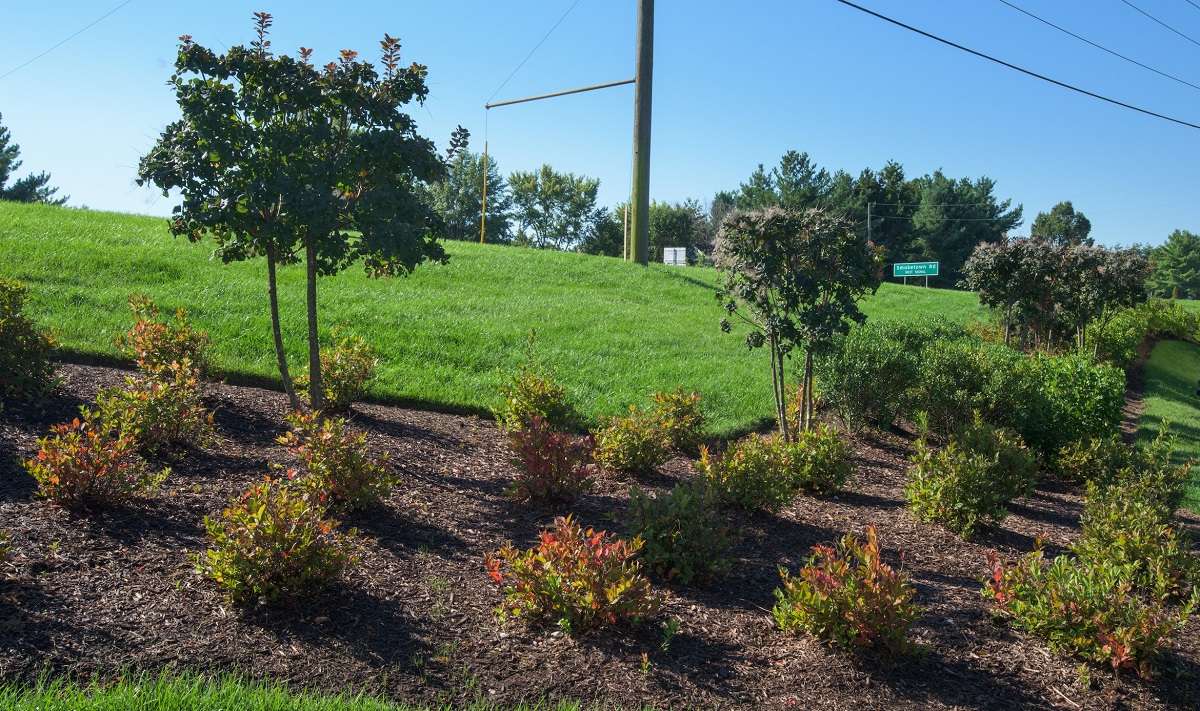
The Best Landscape Edging Tips For Commercial Properties
The difference between so-so landscaping and that crisp, perfect look often comes down to edging.
Edging keeps grass from growing into mulch, corrals gravel so it doesn’t stray into flower beds and just makes everything look tidy.
But what type of edging is best? Aluminum? Plastic? Stone? Or just a nice neat trench?
Paul Weaver, construction branch manager at Level Green Landscaping, shares his expert landscape edging tips.
A Tidy, Shoveled Landscape Edge
 By far, the most common edging we do here at Level Green is the simplest, Weaver says — a neat, cut edge between turf and pavement or mulch.
By far, the most common edging we do here at Level Green is the simplest, Weaver says — a neat, cut edge between turf and pavement or mulch.
The four-inch deep trench, cut with a shovel or an edging tool, stops grass from growing into flower beds, requires little maintenance and lasts a year.
“It’s the most common landscape edging we do,” Weaver says. “It can be straight, it can be curved, and it needs little maintenance. We just hit it with a weed whacker once a week.”
Aluminum Landscape Edging
While we love a simple cut edge, some commercial landscaping requires a bit more.
Sturdy aluminum edging offers a crisp, straight metal edge that works great for several purposes, Weaver says
- Lining a gravel “drip edge” between a building and turf or mulch to catch rainwater. If rain gutters drip into planting beds, they drown the plants. A border of gravel neatly catches the excess water, but it needs sturdy aluminum edging to keep the gravel from migrating into lawn, mulch or planting beds.
- Aluminum edging offers a more permanent edge than a simple cut edge, Weaver says. It’s more expensive, but if you want crisper, longer-lasting landscape edging, aluminum is a good choice. It comes in several colors, too, so you can choose green, brown or black.
Plastic Edging
We’re not talking about the rolls of flimsy plastic edging you can buy at the home improvement store. Weaver has little use for that stuff.
“It’s hard to keep straight, it flops over and it just doesn’t look nice and crisp,” he says.
Level Green crews use high-quality rigid plastic landscape edging surrounding concrete pavers to hold the pavers nicely in place.
This sturdy plastic edging is great for commercial landscapes because it keeps the pavers from spreading from foot traffic, cars and freezing and thawing. Without it, pavers can sink, shift and create spaces for weeds and moss to move in.
These uneven pavers are a tripping hazard, too.
Granite Block Or Stone Edging
 Sometimes a job calls for a bit of extra decorative oomph.
Sometimes a job calls for a bit of extra decorative oomph.
Another landscape edging tip, eight by four-inch granite blocks are great for edging.
“Used in a line, they’re very decorative, plus they do a nice job separating gravel from mulch,” Weaver says.
Get An Edge With Level Green Landscaping
The question isn’t if you need landscape edging. Trust us — you do.
You can also trust Level Green pros to recommend just the right edging for your commercial landscaping needs, whether it’s a nice neat trench, sturdy aluminum or a more decorative stone treatment.
We know all the landscape edging tips.
If you’re not already a Level Green Landscaping client, we’d love to add you to our growing list of happy customers.
Our focus is on commercial properties like offices, mixed-use sites, HOAs, municipalities and institutions in Maryland, Washington DC and parts of Virginia.
Contact us at 202-544-0968. You can also request a free consultation online to meet with us one-on-one.
We’d love to hear from you.

Douglass Delano
Doug Delano (and Bill Hardy) opened Level Green Landscaping LLC in 2002 to offer Washington DC, Maryland and Virginia reliable commercial landscape maintenance services.

